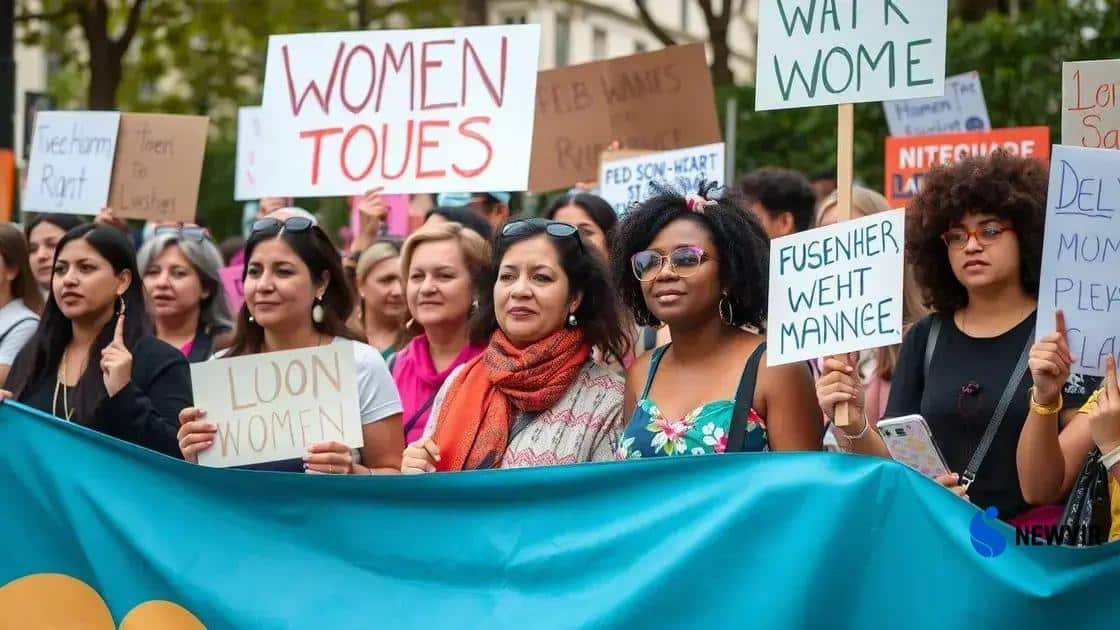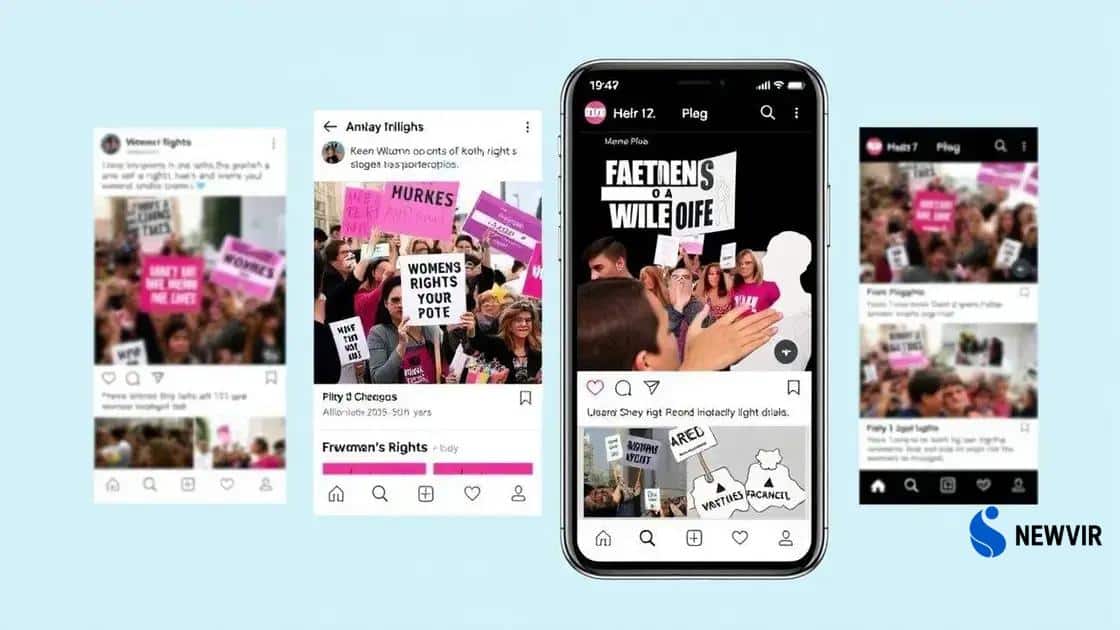Women’s rights demonstrations and public mobilizations: a growing wave

The future of women’s rights activism relies on technology, coalition building, and personal storytelling while addressing challenges like misinformation and online harassment to ensure impactful advocacy.
Women’s rights demonstrations and public mobilizations have become powerful agents of change in recent years. Have you noticed how these movements are reshaping conversations and driving social progress? Let’s dive into their significance.
Historical context of women’s rights
The historical context of women’s rights is rooted in centuries of struggle and activism. Understanding where we came from helps to illuminate the journey of women’s rights activists.
In the 19th century, the fight began to take shape. Women started organizing to demand equal rights, focusing on education and suffrage. The first women’s rights convention, held in Seneca Falls in 1848, marked a significant turning point in the movement.
Key Milestones in Women’s Rights History
As the movement evolved, several key milestones paved the way for modern feminism.
- Women’s suffrage movement in the early 20th century culminated in the 19th Amendment in 1920.
- The Feminine Mystique published in 1963 reignited interest in women’s rights.
- Title IX, passed in 1972, prohibited sex-based discrimination in federally funded education.
The second wave of feminism in the 1960s and 70s focused on reproductive rights and workplace equality. These decades saw protests and events that amplified women’s voices across the nation.
Following this, the global women’s rights movement expanded. Women from diverse backgrounds began uniting to address various issues including race, class, and sexuality. Each aspect brought new challenges and perspectives, enriching the movement.
Many activists worked tirelessly, facing backlash but never relenting. Their efforts laid the groundwork for what we recognize today as women’s rights.
Understanding this historical backdrop allows us to appreciate the ongoing fight for equality. The struggle continues, but it’s important to recognize how far we’ve come and the battles still ahead.
Key events and movements in women’s demonstrations
Throughout history, various key events and movements have significantly influenced women’s demonstrations and the fight for equal rights. These events highlight the bravery and determination of countless women.
One of the earliest pivotal moments was the Seneca Falls Convention in 1848. At this gathering, activists like Elizabeth Cady Stanton and Lucretia Mott outlined important demands for women’s rights, including the right to vote. This convention laid the foundation for future activism.
The Suffrage Movement
The suffrage movement gained momentum in the late 19th and early 20th centuries. Women organized parades, rallies, and protests to advocate for their voting rights. The efforts intensified, leading to the passage of the 19th Amendment in 1920. This accomplishment was a remarkable victory, yet it was only the beginning of a longer struggle.
Another significant event, International Women’s Day, which began in the early 1900s, continues to serve as a platform for protests worldwide. On March 8th, women gather to call for gender equality, demanding action on issues like pay equity and reproductive rights.
Modern Movements
In the 21st century, movements like #MeToo and Women’s March have emerged, uniting women globally to confront sexual harassment and advocate for social justice. These demonstrations have utilized social media to amplify their messages, connecting diverse groups with shared goals.
- Women’s March 2017: Millions participated, protesting for women’s rights and social justice.
- #MeToo Movement: A campaign that raised awareness about sexual harassment and assault.
- Time’s Up: Established to fight against workplace discrimination and harassment.
These events underscore the ongoing struggle for women’s rights, reflecting a rich history of activism. Each demonstration adds a layer to the collective fight, reminding us of the resilience and strength within the movement.
Impact of social media on mobilizations

The impact of social media on mobilizations has transformed how movements organize and communicate. Social media platforms facilitate rapid sharing of information and allow activists to reach wide audiences.
One major benefit is the ability to quickly spread awareness about issues. For example, hashtags like #MeToo have galvanized support across different demographics, making the conversation about sexual harassment more inclusive. Social media has enabled countless individuals to share their stories, fostering solidarity and understanding.
Real-Time Communication
Social media enables real-time communication during events. Activists can share updates, live-stream protests, and call for immediate action. This immediacy boosts engagement and encourages more people to join demonstrations.
- Live streaming allows activists to document events as they happen.
- Posts about upcoming rallies can be shared quickly, increasing attendance.
- Online communities provide support and resources for those involved.
Moreover, social media serves as a platform to organize grassroots movements. Users can create local groups to discuss specific issues, organize meetings, and mobilize support. By connecting with like-minded individuals, activists can build larger networks that amplify their voice.
Challenges and Concerns
Despite the positive aspects, there are challenges. Misinformation can spread as quickly as valuable information. Activists must be cautious to verify sources before sharing content. Additionally, online harassment has been a concern for many, especially marginalized voices within the movement.
Ultimately, the relationship between social media and mobilizations is complex. While social media can enhance activism, it requires careful navigation to maximize its benefits while minimizing risks.
Personal stories from activists
Personal stories from activists highlight the real impact of movements for women’s rights. These narratives often inspire others and demonstrate the power of individual experiences in shaping activism.
One powerful story is that of Malala Yousafzai, who stood up for girls’ education in Pakistan. At just 15 years old, Malala was shot by the Taliban for speaking out. Her bravery not only made her a global icon but also emphasized the importance of educational rights for all girls.
Voices from the March
During the Women’s March in 2017, countless individuals shared their personal reasons for participating. Many spoke about their experiences with harassment, inequality, and the need for change. These emotional testimonies created a profound sense of unity.
- Some activists shared their struggles for reproductive rights, emphasizing the importance of bodily autonomy.
- Others discussed their challenges in the workplace, advocating for equal pay and opportunities.
- Testimonies of women from various backgrounds showcased the diverse issues within the movement.
These stories are often shared through social media, amplifying grassroots activism. Activists use platforms to connect personally with supporters, creating a narrative that resonates and builds a community around shared experiences.
Another significant activist is Tarana Burke, the founder of the #MeToo movement. She began this initiative to help survivors of sexual violence share their stories. Her work has encouraged many to find their voice and join the battle against harassment.
Activists show that the fight for women’s rights is not just about policies but also about real lives and personal journeys. Their stories help to humanize the issues, driving more people to join the cause.
Future of women’s rights activism
The future of women’s rights activism appears bright yet challenging. Activists continue to explore new ways to advocate for equality in an ever-changing world. As technology advances, so do the strategies used to mobilize support and raise awareness.
One significant aspect is the increased collaboration across different movements. Activists are joining forces with other campaigns, such as those focusing on climate change, racial equality, and LGBTQ+ rights. This intersectionality strengthens the impact of the women’s rights movement. As a united front, they tackle overlapping issues, showing that the struggle for equality is interconnected.
Embracing Technology
Technology plays a crucial role in shaping the future of activism. Social media platforms now serve as powerful tools for organizing protests, sharing stories, and mobilizing supporters. Moreover, technology helps in reaching underrepresented groups more effectively.
- Apps and websites allow activists to connect, share resources, and coordinate events efficiently.
- Online campaigns can create viral movements, bringing global attention to local issues.
- Digital storytelling helps amplify voices that might be overlooked.
Furthermore, the rise of artificial intelligence and data analysis can assist organizations in understanding trends and customizing their approaches to advocacy. Using data, activists can better target their messaging to resonate with specific audiences.
Emerging Challenges
Despite the promising developments, challenges remain. Issues like disinformation and online harassment threaten to undermine the movement. Activists must develop robust strategies to counter these threats and ensure safety and accuracy in their communications.
As the landscape of activism evolves, so too do the tactics employed by activists. For example, younger activists are increasingly focusing on sustainability and climate justice as integral elements of their fight for women’s rights. They recognize that environmental issues disproportionately affect women, particularly in developing countries.
Additionally, there’s a growing emphasis on mental health in activism. Recognizing the toll that advocacy can take, many organizations are prioritizing the well-being of their members.
FAQ – Questions about the future of women’s rights activism
How is technology influencing women’s rights activism?
Technology enables activists to mobilize quickly, share stories, and connect with a wider audience, enhancing their efforts.
What role do personal stories play in activism?
Personal stories create empathy and solidarity, making the issues more relatable and encouraging more individuals to get involved.
Why is coalition building important in women’s rights activism?
Coalition building allows different movements to unite, strengthening their impact and addressing intersecting issues effectively.
What challenges do activists face in the digital age?
Activists face challenges such as misinformation and online harassment, necessitating strategies to ensure their safety and the integrity of their message.






